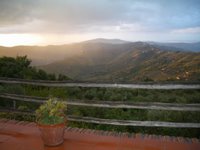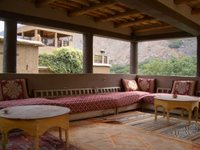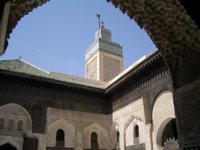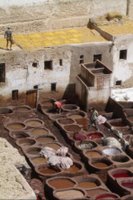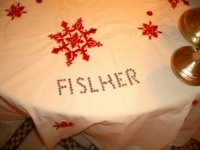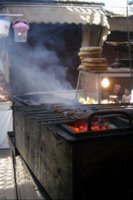 To complete the trilogy of Morocco postings, the last installment is Marrakech. After returning from the mountains, stomachs unsettled and legs very sore, we arrived in Marrakech at our Riad: Riad L'Orangeraie. Owned by some Frenchmen, this was a chicer version of the riad concept: Minimalist sort-of-African, sort-of-Balinese dark wood and muted fabrics decor. Same courtyard layout, this time with two courtyards, and a great roof deck with benches and chaises with the chic-required white pillows. A little dipping pool to refresh. A few sitting rooms scattered around. Bathrooms with big tubs. Just right.
To complete the trilogy of Morocco postings, the last installment is Marrakech. After returning from the mountains, stomachs unsettled and legs very sore, we arrived in Marrakech at our Riad: Riad L'Orangeraie. Owned by some Frenchmen, this was a chicer version of the riad concept: Minimalist sort-of-African, sort-of-Balinese dark wood and muted fabrics decor. Same courtyard layout, this time with two courtyards, and a great roof deck with benches and chaises with the chic-required white pillows. A little dipping pool to refresh. A few sitting rooms scattered around. Bathrooms with big tubs. Just right.Marrakech has a few more "sights" than Fes, but again the biggest entertainment value was in the wandering. And the shopping. Good shopping here. Western tourists were in far greater abundance here (word is it's where the cool kids in Paris come for the weekend, which was evident in the restaurants, discussed further below). Anyways, some of the key sights:
Djemma el Fna. The main square in town. Not much to see in terms of architecture or layout, it's really a people watching attraction. Now, the traditional food vendors, storytellers and snake charmers are far outnumbered by backpackers and
 pasty European tour groups. But it's still good people watching. The thing to do is to take a perch in a cafe around the square and linger. We sampled a couple: Best cafe for actually eating is definitely Cafe Argana; best view is Cafe Glacier. There's a little row of orange juice vendors (lots of fresh orange juice in Morocco) that Mike rather enjoyed that's open all day, too. At night, the vendors emerge around dusk to set up a little village of food stalls. Unfortunately, our mountain food-recovering stomachs preventing us from sampling the wares, but there looked to be some pretty good variations of grilled meat on offer. I'd stay away from salads and other items that don't have the bugs cooked off - not a whole lot of cleaning going on.
pasty European tour groups. But it's still good people watching. The thing to do is to take a perch in a cafe around the square and linger. We sampled a couple: Best cafe for actually eating is definitely Cafe Argana; best view is Cafe Glacier. There's a little row of orange juice vendors (lots of fresh orange juice in Morocco) that Mike rather enjoyed that's open all day, too. At night, the vendors emerge around dusk to set up a little village of food stalls. Unfortunately, our mountain food-recovering stomachs preventing us from sampling the wares, but there looked to be some pretty good variations of grilled meat on offer. I'd stay away from salads and other items that don't have the bugs cooked off - not a whole lot of cleaning going on. Koutoubia Mosque. Can't go in unless you're Muslim, but a striking minaret, handy for orientation purposes around town. The gardens behind are lovely for a little break from the crowds. (Sadly, the grande dame hotel, La Mamounia, was under massive renovations when we were there, so we did not get to enjoy the gardens or hotel there).
Koutoubia Mosque. Can't go in unless you're Muslim, but a striking minaret, handy for orientation purposes around town. The gardens behind are lovely for a little break from the crowds. (Sadly, the grande dame hotel, La Mamounia, was under massive renovations when we were there, so we did not get to enjoy the gardens or hotel there).Ben Youssef Medersa. Lacking the atmospheric decay of the medersas in Fes, this place was clearly a tourist destination. It is, however, still striking and
 beautiful. As with all of the medersas, I found the combination of symmetry and incredible detail beautiful.
beautiful. As with all of the medersas, I found the combination of symmetry and incredible detail beautiful.Badi Palace. One of the oodles of palaces, in various degrees of upkeep, around town. Impressive in scale, less so in decoration at this point. In the far left corner, though, you can go up to the roof for a good view of the city.
Marrakech museum. In a restored palace, with a lovely little cafe in the entrance courtyard (that you can get to without paying for museum entrance). I would definitely recommend this as a rest stop during a hot day in the alleys of Marrakech. The museum itself is lovely, with lots of nooks with well-positioned chairs for resting around a fountain. The strange yellow light from the enclosed courtyard is a bit off-putting, but you can't have everything. Aside from the standard fare (carpets, ceremonial jewelry, tea sets, etc.), there was an interesting collection of old photographs in one of the side galleries.
 Jardin Majorelle. These gardens, a bit outside the medina, were once the home of artist Jacques Majorelle, but are now owned (I think) and kept up by Yves St. Laurent. Thus, they are tres chic. We took a horse and carriage ride there, which was touristy but fun, although you could probably walk it in about 30 minutes. The gardens are lovely - lots of tropical plants with matching intensely colored pots and reflecting pools, all surrounding the old residence, now painted an intense blue and housing a small museum. They were a bit crowded when we were there, but definitely lovely.
Jardin Majorelle. These gardens, a bit outside the medina, were once the home of artist Jacques Majorelle, but are now owned (I think) and kept up by Yves St. Laurent. Thus, they are tres chic. We took a horse and carriage ride there, which was touristy but fun, although you could probably walk it in about 30 minutes. The gardens are lovely - lots of tropical plants with matching intensely colored pots and reflecting pools, all surrounding the old residence, now painted an intense blue and housing a small museum. They were a bit crowded when we were there, but definitely lovely.Shopping. There are, of course, the souks for wandering. The souks of Marrakech were much more extensive than those in Fes, and clearly much more aligned with the
 tastes of the western tourist. Which isn't necessarily a bad thing, I suppose. Anyways, metal work and jewelry and sandals and linens and caftans and woodwork and carpets and the whole list of crafty items are on offer. There are some that are clearly tied to a particular craftsman and some that are clearly more "nouveau" Moroccan. Bargaining is de rigeur, regardless of where you shop. (My experience was regular use of the line "you must have been born a berber" in response to extensive bargaining - some sort of ethnic stereotype with which I was not familiar).
tastes of the western tourist. Which isn't necessarily a bad thing, I suppose. Anyways, metal work and jewelry and sandals and linens and caftans and woodwork and carpets and the whole list of crafty items are on offer. There are some that are clearly tied to a particular craftsman and some that are clearly more "nouveau" Moroccan. Bargaining is de rigeur, regardless of where you shop. (My experience was regular use of the line "you must have been born a berber" in response to extensive bargaining - some sort of ethnic stereotype with which I was not familiar).We picked up lanterns for our back porch, fun caftans for beach coverups, and some brightly colored berber rugs, of which I'm growing rather fond, among other things. As always, I regret not buying twice as much of everything.
Restaurants. We had breakfast in the riad, which was superb - breads of the French and Moroccan variety, fruit, good coffee. Lunch was generally picnic style or in one of the little cafes we happened onto.
Marrakech was definitely a more western dining experience for us than Fes (or the Atlas Mountains). This was in part due to my chicken tagine boycott and in part due to the fact that we delegated to our hosts Cyril at the Riad for suggestions. (And that is the plural of Cyril: there is Cyril the owner in Paris and Cyril the on-site manager - both were great, once we sorted out that there were two Cyrils). The first night we had dinner at the Riad, which was a spectacular setting by the candlelit pool, but something I probably would have enjoyed even more at the beginning of the trip, as it was generally the standard menu.
Night two was Bo Zin. Moroccan-Thai, obviously. Definitely fun, if only for the change of pace. If it had been a touch warmer out, the garden with its flowing white sheets and torches would have been super fun for an evening of imbibing. Downside is it's a 15 minute taxi ride outside the medina. Upside is there's a chauffeured car complete with Hotel Costes-esque soundtrack to take you home.
Next night was Le Foundouk, my favorite restaurant of the trip. An old caravaneserai with a bar on the first floor, dining tables around the open balcony on the second floor, and a roof terrace on the third level. Definitely the best combination of Moroccan-modern decor and Moroccan food for the sophisticated western palate. My pastilla was brilliant and the wine list was definitely the best one we'd seen. My only regret is that we didn't go back another night for drinks on the roof.
Our final dinner was at Le Comptoir, an offshoot of a restaurant in Paris. It was just a little too themey for my tastes (can we say belly-dancing show), and the middle-aged British couples on either side of us didn't help. A drink at the bar upstairs would have been a better choice.
All in all, we took a mid range approach to Marrakech, which could have been done far
 more lavishly or far more backpackery. Obviously, any trip to Morocco would be silly without Marrakech, but I think it particularly well-suited for what I think is a burgeoning weekend market. It's sort of Morocco-lite - just enough culture and caravan-fantasy but still room for shopping and cocktails. That said, I think I'd like to spend longer there to get to know some of the back alleys and such - it felt like the kind of place that you might be able to really get to know with some time.
more lavishly or far more backpackery. Obviously, any trip to Morocco would be silly without Marrakech, but I think it particularly well-suited for what I think is a burgeoning weekend market. It's sort of Morocco-lite - just enough culture and caravan-fantasy but still room for shopping and cocktails. That said, I think I'd like to spend longer there to get to know some of the back alleys and such - it felt like the kind of place that you might be able to really get to know with some time.


